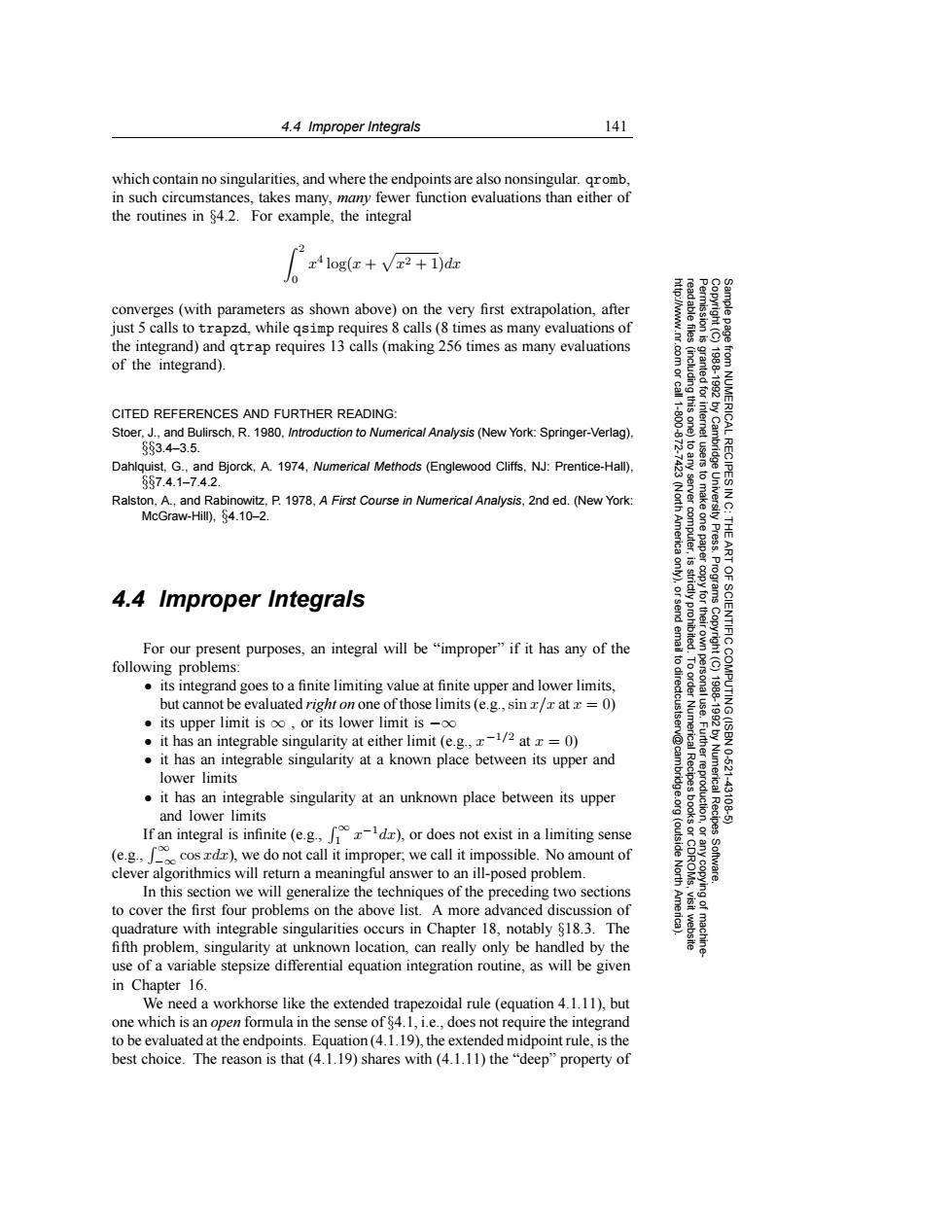正在加载图片...

4.4 Improper Integrals 141 which contain no singularities,and where the endpoints are also nonsingular.gromb. in such circumstances,takes many,many fewer function evaluations than either of the routines in 84.2.For example,the integral ^2 rlog(x+Vr2+1)dz /0 converges (with parameters as shown above)on the very first extrapolation,after just 5 calls to trapzd,while qsimp requires 8 calls(8 times as many evaluations of the integrand)and qtrap requires 13 calls(making 256 times as many evaluations of the integrand). CITED REFERENCES AND FURTHER READING: Stoer,J.,and Bulirsch,R.1980,Introduction to Numerical Analysis (New York:Springer-Verlag). 5853.4-3.5. Dahlquist,G.,and Bjorck,A.1974,Numerica/Methods (Englewood Cliffs,NJ:Prentice-Hall), $87.4.1-7.4.2. RECIPES I Ralston,A.,and Rabinowitz,P.1978,A First Course in Numerical Analysis,2nd ed.(New York: McGraw-Hill),$4.10-2. 。 令 Press. 4.4 Improper Integrals IENTIFIC For our present purposes,an integral will be"improper"if it has any of the following problems: 6 its integrand goes to a finite limiting value at finite upper and lower limits, but cannot be evaluated right on one of those limits (e.g.,sin x/x at x =0) its upper limit is oo,or its lower limit is -oo it has an integrable singularity at either limit(e.g.,1/2 at0) it has an integrable singularity at a known place between its upper and lower limits Recipes Numerica 10.621 it has an integrable singularity at an unknown place between its upper 431 and lower limits If an integral is infinite (e.g.),or does not exist in a limiting sense Recipes (e.gco)we do not call it improper,we call it impossible.No amount of (outside 腿 clever algorithmics will return a meaningful answer to an ill-posed problem. North In this section we will generalize the techniques of the preceding two sections to cover the first four problems on the above list.A more advanced discussion of quadrature with integrable singularities occurs in Chapter 18,notably 818.3.The fifth problem,singularity at unknown location,can really only be handled by the use of a variable stepsize differential equation integration routine,as will be given in Chapter 16. We need a workhorse like the extended trapezoidal rule (equation 4.1.11),but one which is an open formula in the sense of 84.1,i.e.,does not require the integrand to be evaluated at the endpoints.Equation(4.1.19),the extended midpoint rule,is the best choice.The reason is that (4.1.19)shares with(4.1.11)the"deep"property of4.4 Improper Integrals 141 Permission is granted for internet users to make one paper copy for their own personal use. Further reproduction, or any copyin Copyright (C) 1988-1992 by Cambridge University Press. Programs Copyright (C) 1988-1992 by Numerical Recipes Software. Sample page from NUMERICAL RECIPES IN C: THE ART OF SCIENTIFIC COMPUTING (ISBN 0-521-43108-5) g of machinereadable files (including this one) to any server computer, is strictly prohibited. To order Numerical Recipes books or CDROMs, visit website http://www.nr.com or call 1-800-872-7423 (North America only), or send email to directcustserv@cambridge.org (outside North America). which contain no singularities, and where the endpoints are also nonsingular. qromb, in such circumstances, takes many, many fewer function evaluations than either of the routines in §4.2. For example, the integral 2 0 x4 log(x + x2 + 1)dx converges (with parameters as shown above) on the very first extrapolation, after just 5 calls to trapzd, while qsimp requires 8 calls (8 times as many evaluations of the integrand) and qtrap requires 13 calls (making 256 times as many evaluations of the integrand). CITED REFERENCES AND FURTHER READING: Stoer, J., and Bulirsch, R. 1980, Introduction to Numerical Analysis (New York: Springer-Verlag), §§3.4–3.5. Dahlquist, G., and Bjorck, A. 1974, Numerical Methods (Englewood Cliffs, NJ: Prentice-Hall), §§7.4.1–7.4.2. Ralston, A., and Rabinowitz, P. 1978, A First Course in Numerical Analysis, 2nd ed. (New York: McGraw-Hill), §4.10–2. 4.4 Improper Integrals For our present purposes, an integral will be “improper” if it has any of the following problems: • its integrand goes to a finite limiting value at finite upper and lower limits, but cannot be evaluated right on one of those limits (e.g.,sin x/x at x = 0) • its upper limit is ∞ , or its lower limit is −∞ • it has an integrable singularity at either limit (e.g., x−1/2 at x = 0) • it has an integrable singularity at a known place between its upper and lower limits • it has an integrable singularity at an unknown place between its upper and lower limits If an integral is infinite (e.g., ∞ 1 x−1dx), or does not exist in a limiting sense (e.g., ∞ −∞ cos xdx), we do not call it improper; we call it impossible. No amount of clever algorithmics will return a meaningful answer to an ill-posed problem. In this section we will generalize the techniques of the preceding two sections to cover the first four problems on the above list. A more advanced discussion of quadrature with integrable singularities occurs in Chapter 18, notably §18.3. The fifth problem, singularity at unknown location, can really only be handled by the use of a variable stepsize differential equation integration routine, as will be given in Chapter 16. We need a workhorse like the extended trapezoidal rule (equation 4.1.11), but one which is an open formula in the sense of §4.1, i.e., does not require the integrand to be evaluated at the endpoints. Equation (4.1.19), the extended midpoint rule, is the best choice. The reason is that (4.1.19) shares with (4.1.11) the “deep” property of���